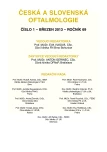Bilateral Neuroretinitis as an Ocular Manifestation of Cat Scratch Disease in 9-year-old Boy. A Case Report
Authors:
D. Petrušková 1; P. Pochop 1; M. Kodetová 1; B. Obermannová 2; D. Dotřelová 1
Authors place of work:
Oční klinika dětí a dospělých 2. LF UK
a FNM, Praha, přednosta prof. MUDr. Dagmar Dotřelová, CSc., FEBO
1; Pediatrická klinika 2. LF UK a FNM, Praha 5, přednosta prof. MUDr. Jan Lebl, CSc.
2
Published in the journal:
Čes. a slov. Oftal., 69, 2013, No. 1, p. 26-29
Category:
Kazuistika
Summary
Purpose:
1. To highlight a less-known clinical entity neuroretinitis and the need for differentiation of this entity from the other retinal disease that can mimic. 2. To be familiar with ocular finding in Cat scratch disease.
Material and methods:
Case report. Authors describe a clinical course of bilateral neuroretinitis in a 9-year-old boy who was referred to our clinic with painless decreased corrected visual aquity in the right eye (6/18) and in the left eye (6/9). Fundus examination disclosed bilateral stellate maculopathy. Patient had a history of close contact with a cat. Serologic tests for infective disease confirmed the presence of IgG antibody against Bartonella henselae (1 : 64). Specific antibiotic treatment with bacteriostatical activity against Bartonella henselae restored functional and anatomical changes in both of eyes within two month.
Results:
Noninfective etiology of bilateral neuroretinitis was essential to exclude in differential diagnosis. Diagnosis of Cat scratch disease was based on positive epidemiological diagnosis, bilateral manifestation of neuroretinitis, high IgG antibody titre against Bartonella henselae and successful treatment of this disease after specific antibiotic therapy.
Conclusion:
Neuroretinitis is the most common ocular manifestation of cat scratch disease. Familiarity with differential diagnosis of neuroretinitis is essential for prompt causal treatment initialisation.
Key words:
cat scratch disease, bilateral stellate maculopathy, neuroretinitis, boy
Zdroje
1. Cunningham, E.T., Koehler, J.E.: Ocular bartonellosis. Am J Ophthalmol, 130; 2000 : 340–349.
2. Darsová, D., Pochop, P., Korolová, M., Baráková, D., Dotfielová, D.: Lymeská borelióza jako příčina bilaterální neuroretinitidy s výraznou jednostrannou hvězdicovitou makulopatií u osmileté dívky. Cesk Slov Neurol N, v tisku.
3. Hercík, K., Hášová, V., Janeček, J., Branny, P.: Molecular evidence of Bartonella DNA in Czechia. Folia Microbiol, 52; 2007 : 503–509.
4. Chomel, B.B., Boulouis, H.J., Maruyama, S., Breitschwerdt, E.B.: Bartonella Spp. in pets and effect on human health. Emerg Infect Dis, 12; 2006 : 389–394.
5. Melter, O., Hercík, K., Weyantc, R.S., Janeček, J., et al.: Detection and characterization of feline Bartonella henselae in the Czech Republic. Vet Microbiol, 93; 2003 : 261–273.
6. Ray, S., Gragoudas, E.: Neuroretinitis. Int Ophthalmol Clin, 41; 2001 : 83–102.
7. Říhová, E.: Nemoc kočičího škrábnutí. Říhová, E., et al.: Uveitidy. 1. vyd. Grada Publishing, Praha 2009, ISBN 978-80-247-2897-1, 134 s.
8. Suhler, E.B., Lauer, A.K., Rosenbaum, J.T.: Prevalence of serologic evidence of Cat scratch disease in patients with neuroretinitis. Ophthalmol, 107; 2000 : 871–876.
Štítky
OftalmológiaČlánok vyšiel v časopise
Česká a slovenská oftalmologie

2013 Číslo 1
- Myasthenia gravis: kombinace chirurgie a farmakoterapie jako nejefektivnější modalita?
- Pomocné látky v roztoku latanoprostu bez konzervačních látek vyvolávají zánětlivou odpověď a cytotoxicitu u imortalizovaných lidských HCE-2 epitelových buněk rohovky
- Konzervační látka polyquaternium-1 zvyšuje cytotoxicitu a zánět spojený s NF-kappaB u epitelových buněk lidské rohovky
- Dlouhodobé výsledky lokální léčby cyklosporinem A u těžkého syndromu suchého oka s 10letou dobou sledování
- Syndrom suchého oka
Najčítanejšie v tomto čísle
- Klinické nálezy u členů české rodiny s retinitis pigmentosa podmíněnou mutací v ORF15 genu RPGR
- Oboustranná neuroretinitis jako projev nemoci kočičího škrábnutí u devítiletého chlapce
- Benigní maskující syndrom u pacientky s retinitis pigmentosa
- Evaluace parametrů jednoduchého binokulárního vidění na synoptoforu u zdravé dospělé populace
